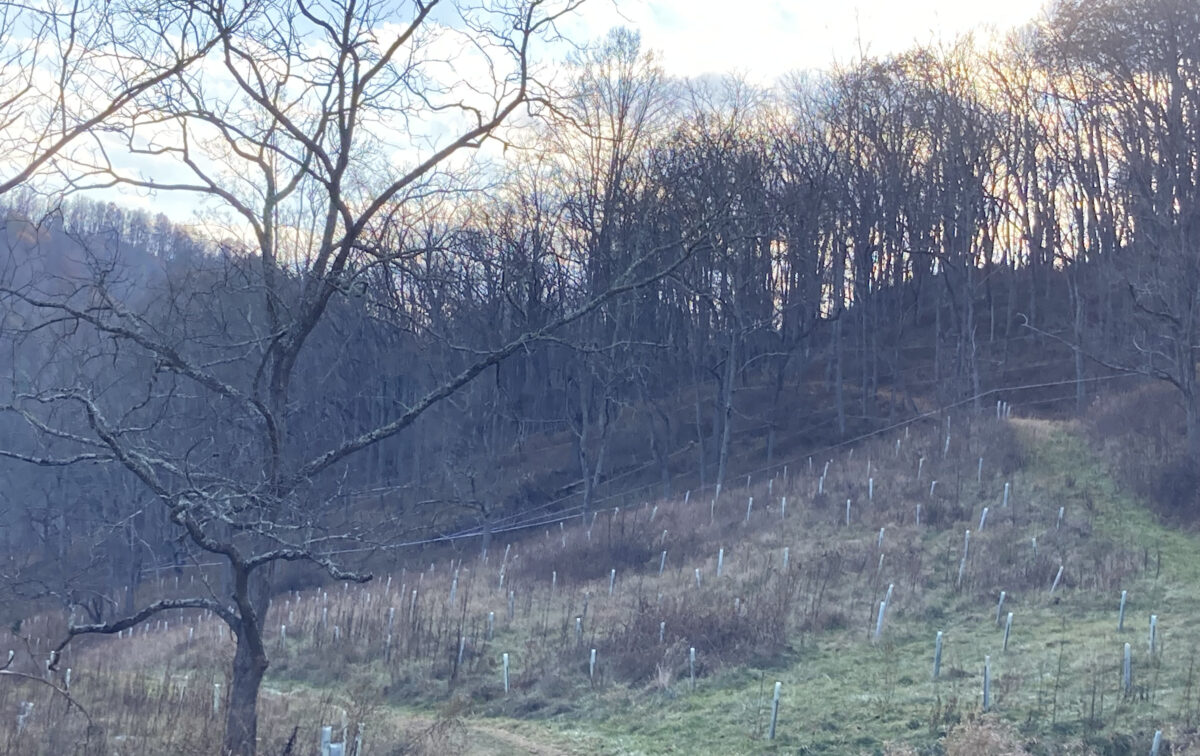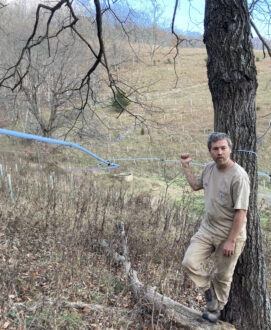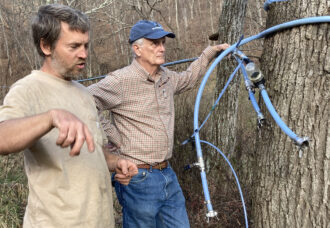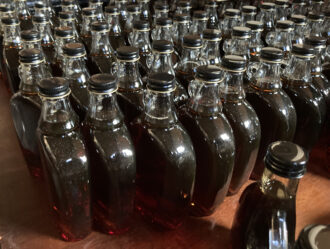MCDOWELL, Virginia – Long before the Civil War, land on the mountainous slopes of the Allegheny Mountains in western Virginia had been cleared for logging and cattle grazing. Today, agriculture is still prominent, but in the form of syrup tapped from hardwoods – maple, hickory, elm, black walnut – that have retaken the landscape.
Syrup production is big business in Virginia, specifically in Highland County where 60 percent to 70 percent of the state’s syrup production occurs. As such, farmers are constantly looking for ways to more efficiently tap trees to increase product and maximize their bottom line during a season that only lasts, at best, two months.
On an unseasonably warm early November day, farmer Will Shepherd of Tonoloway Farm, surveys the hardwoods on the property, his attention focused on sections of black walnut trees cordoned off with blue tubing. The tubing is part of a vacuum system that he’s testing to determine if he can increase the sap flow of the trees. The work is being funded through a Southern Sustainable Agriculture Research and Education (SSARE) On-Farm Research Grant.
“We are trying to figure out the best approaches to maximizing the amount of sap we can extract from black walnut trees,” said Shepherd. While maple syrup is the most common type of syrup produced, other syrup varieties can include hickory and black walnut. Black walnut sap extraction is of particular interest for Tonoloway Farm.

Black walnut syrup is in high demand and commands a premium price, simply because not enough can be produced to satisfy the taste buds of consumers turned on to its nutty, earthy flavor. A 5-ounce bottle of pure black walnut syrup sells for $35, according to the Tonoloway Farm website. Touted as the largest producer of black walnut syrup in North America, Tonoloway Farm consistently sells out of its pure black walnut syrup and black walnut/maple blend – usually during the annual Maple Festival where over 20,000 visitors descend upon the small town of McDowell, VA in March.
The challenge to getting the most sap from each tap is that sap flows from black walnut trees much slower than from sugar bush maples, Virginia Tech researcher Tom Hammett pointed out. The difference, he said, is likely due to physiology of the trees’ vascular systems. Sugar bush maples are diffuse porous, meaning that as the tree puts on layers of growth each year, there is little to no size change in tissue at the cellular level, which allows for rapid flow of sap year to year. By comparison, black walnut trees are semi-diffuse porous, meaning that as the tree puts on layers of growth each year, tissue decreases in size at the cellular level with each new layer, causing a slower flow of sap from the tree.

“The issue is that since the sap flows much slower, farmers don’t get as much sap from the trees, compared to maples,” said Hammett, who focuses on non-timber products in the area of Sustainability, Innovation and Design. “The ratio of sap to gallon of syrup is the same between black walnut trees and sugar bush maples (40 gallons of sap makes one gallon of syrup), but black walnuts produce seven times less volume. Farmers have to tap more black walnuts to match what one sugar bush maple would produce.”
In recent times, the maple syrup industry has shifted from drip harvest methods to vacuum tubing systems; maple trees respond to negative pressure at the tap hole with increased sap flow. Preliminary research has shown that black walnut trees also respond well to vacuum with increase sap flow. But finding the right vacuum system is important, said Hammett.
“There are two methods of vacuum used in the maple industry: gravity pulling on capillary action through 3/16” tubing, and mechanical vacuum through either 3/16” or 5/16” tubing. While capillary vacuum works well with maple, walnut trees release more gas into the sap lines, which reduces the transmission of vacuum through the line,” said Hammett. “It remains unclear if high levels of vacuum can be transmitted with walnut sap all the way up 3/16” and 5/16” tubing.”
In the Southern SARE On-Farm Research Grant, Hammett and Shepherd are testing various sap extraction vacuum systems with different tube sizes: A 3/16” gravity vacuum line, a 3/16” line with mechanical vacuum pump, and a 5/16” line with mechanical vacuum pump. Measurements were taken at 56 points across 6 sap lines. Data was collected four times during the course of a sap harvest season.
Research is ongoing, but preliminary data suggests that the 5/16” tube size was highly effective at transmitting vacuum up the lines mechanically. The 3/16” tube size did not effectively transmit the vacuum mechanically up the lines. Under the right circumstances, the 3/16” gravity lines have potential to outperform the mechanical systems with both 3/16” and 5/16” tubing.

Hammett said that the 5/16” line vacuum systems were the most effective, but are more challenging to install because they do not tolerate any elevation rise, and they are also difficult to check for leaks because sap flow is less visible. He indicated that 3/16” gravity lines are a good candidate for small-scale operations, or good for areas where a vacuum pump would be difficult to set up.
“Final data will provide evidence to inform recommendations on types of tubing systems, the maximum length of lines, and cost-benefit ratio of mechanical versus natural vacuum systems. These findings would help to provide guidance for development of new walnut syrup businesses, including the most cost-effective systems,” said Hammett. “With this information, new farms and forest landowners can enter the walnut syrup market using existing technology without the risk of costly trial and error.”
Another aspect of the Southern SARE On-Farm Research Grant involved conducting taste tests of black walnut syrup so that a grading system of flavor profiles can be developed to help consumers make more informed purchasing choices. This work is ongoing.
